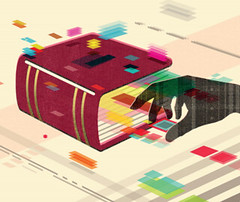
PREV ARTICLE
NEXT ARTICLE
FULL ISSUE
PREV FULL ISSUE
CURATING THE DIGITAL AGE Les Citrome forwarded this article on digital curation from the April 2016 issue of IEEE Spectrum. Thanks. It defines a number of
digital-age vocabulary words that readers ought to become familiar with. See the complete aticle online for more terms, including dark
archives and media migration. All of these have relevance to the work of the Newman Numismatic Portal. -Editor Les Citrome forwarded this article on digital curation from the April 2016 issue of IEEE Spectrum. Thanks. It defines a number of
digital-age vocabulary words that readers ought to become familiar with. See the complete aticle online for more terms, including dark
archives and media migration. All of these have relevance to the work of the Newman Numismatic Portal. -Editor
[T]he belief that our life offline is separate from our life online has been denounced as digital dualism. But there’s less of a debate when it comes to differentiating between analog objects and digital data. Yes, the print and electronic copies of the same book contain the same words, but it’s obvious to most people (and, increasingly, to researchers) that the two reading experiences are quite different. We need to understand such differences because the world is going to see a lot more digital data in the near future. This includes born-digital data, which is originally created in an electronic format, as well as born-analog data, which starts life as a physical object and then is reborn digital. A great example of this digitization came earlier this year when the New York Public Library announced that it was making more than 180,000 digitized items available to anyone with an Internet connection, no questions asked. That librarians would turn themselves into digital curators is no surprise, since as analog curators for the past few centuries they have been constantly bumping into the physical constraints of storage space and material decay. One approach is to get rid of stuff, and librarians and archivists employ a pleasing variety of terms related to the removal of unwanted or duplicate material from their collections: Weeding and culling generally refer to the removal of individual items, while purging, screening, and stripping are most often used for the removal of multiple related items. But the main problem with physical materials is that they possess what archivists call, poetically, inherent vice: the tendency for something to deteriorate over time because of some fault in the material itself (for example, the presence of lignin in cheap paper, which causes the paper to yellow) or the way the material reacts with its surroundings (for instance, the fact that bugs eat some books because they’re attracted to the mold that grows in damp paper). The digitization of analog materials can solve these problems, and engineers are constantly trying to find faster ways to turn atoms into bits. For now, though, we mostly have to rely on the skills of scanops (scanner operators) to generate those bits, although on their less skilled days those operators end up scanning their own body parts, such as fingers and hands, a phenomenon known as Google hands. Some companies are applying the principles of crowdsourcing and gamification to the digitizing realm, creating leisure activities that let users contribute to the process. To read the complete article, see:
Wayne Homren, Editor The Numismatic Bibliomania Society is a non-profit organization promoting numismatic literature. See our web site at coinbooks.org. To submit items for publication in The E-Sylum, write to the Editor at this address: whomren@gmail.com To subscribe go to: https://my.binhost.com/lists/listinfo/esylum All Rights Reserved. NBS Home Page Contact the NBS webmaster 
|